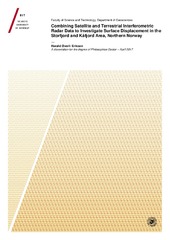| dc.contributor.advisor | Bergh, Steffen | |
| dc.contributor.author | Eriksen, Harald Øverli | |
| dc.date.accessioned | 2017-10-24T07:17:29Z | |
| dc.date.available | 2017-10-24T07:17:29Z | |
| dc.date.issued | 2017-10-10 | |
| dc.description.abstract | Due to their all-weather all-day capabilities and increased availability, synthetic aperture radar (SAR) interferometric displacement datasets have gained popularity in a variety of scientific disciplines. Both satellite and ground-based platforms are used. Satellite-based radar instruments cover large areas on a regular basis without the need for in-situ instrumentation. As with all measuring techniques, radar has its limitations. One intrinsic property is its ability to only observe displacement along the Line-Of-Sight (LOS) direction, thus displacement components diverging from the LOS-direction are underestimated, which limits interpretation of displacement processes. Being portable, the LOS-direction of ground-based radars can be selected. However, as with the satellite-based instruments, ground-based radars still suffer from underestimation of displacement that arises due to divergence from the instrument’s LOS-direction.
In this project, we have combined multi-geometrical radar datasets from ground- and satellite-based radar to form two-dimensional (2D) and three-dimensional (3D) surface displacement vectors, creating new ways to interpret surface deformation. By plotting the resulting 2D and 3D surface displacement vector datasets in map and cross-sections, we interpret displacement at the landform- and landscape-scale.
Using 2D surface displacement vectors produced from scenes acquired by the TerraSAR-X satellite in ascending and descending orbits we have studied rockslides, rock glaciers and solifluction lobes at the landform scale. In addition, we have investigated the use of periglacial landform-specific displacement rates as a tool for geomorphological mapping at the landscape-scale. By also including data from ground-based radar we have calculated 3D surface displacement vectors for the Jettan rockslide. In contrast with single radar datasets, using 2D and 3D surface displacement vectors together with topography enables us to calculate different kinematic diagnostic parameters that can be used as tools for interpretation of displacement patterns. Variations in kinematic diagnostic parameters such as combined displacement velocity, azimuth, dip/plunge, displacement into and out of the slope (subsidence/ uplift), compression/extension (strain rate) and horizontal and vertical components, when plotted in cross-sections, enables us to discuss the processes and, factors controlling observed deformation patterns. The 2D and 3D surface displacement vector datasets produced in this work act as an important contribution together with geomorphological, structural and field data for proposing geological models. | en_US |
| dc.description.doctoraltype | ph.d. | en_US |
| dc.description.popularabstract | Radar remote sensing of unstable slopes is becoming a standard method. A radar is an active instrument that is capable of operating day and night, independent of weather conditions. Satellite radar systems allow regular monitoring of large areas on the Earth's surface. By combining repeated satellite- or ground-based radar observations, it is possible to detect precise terrain displacements in the line-of-sight of the radar. However, the displacement will be underestimated if the true surface displacement differs from the radar line-of-sight. This can make interpretation difficult. By combining satellite- and ground-based radar observations from different geometries, it is possible to provide information about direction and magnitude of surface deformation. This improves understanding of active surface processes such as rockslides and rock glaciers on landform-scale, and the large spatial coverage allows investigating relations between displacement and geomorphology on landscape-scale. | en_US |
| dc.description.sponsorship | This PhD was supported by Troms County Council, project number 217720 and grant number RDA12/165. | en_US |
| dc.identifier.isbn | 978-82-8236-270-2 (trykt) og 978-82-8236-271-9 (pdf) | |
| dc.identifier.uri | https://hdl.handle.net/10037/11679 | |
| dc.language.iso | eng | en_US |
| dc.publisher | UiT Norges arktiske universitet | en_US |
| dc.publisher | UiT The Arctic University of Norway | en_US |
| dc.rights.accessRights | openAccess | en_US |
| dc.rights.holder | Copyright 2017 The Author(s) | |
| dc.subject.courseID | DOKTOR-004 | |
| dc.subject | VDP::Mathematics and natural science: 400::Geosciences: 450::Tectonics: 463 | en_US |
| dc.subject | VDP::Mathematics and natural science: 400::Geosciences: 450::Physical geography: 455 | en_US |
| dc.subject | VDP::Matematikk og Naturvitenskap: 400::Geofag: 450::Naturgeografi: 455 | en_US |
| dc.subject | VDP::Mathematics and natural science: 400::Geosciences: 450::Quaternary geology, glaciology: 465 | en_US |
| dc.subject | VDP::Matematikk og Naturvitenskap: 400::Geofag: 450::Kvartærgeologi, glasiologi: 465 | en_US |
| dc.subject | VDP::Mathematics and natural science: 400::Geosciences: 450::Other geosciences: 469 | en_US |
| dc.subject | VDP::Matematikk og Naturvitenskap: 400::Geofag: 450::Andre geofag: 469 | en_US |
| dc.subject | VDP::Mathematics and natural science: 400::Geosciences: 450 | en_US |
| dc.subject | VDP::Matematikk og Naturvitenskap: 400::Geofag: 450 | en_US |
| dc.title | Combining Satellite and Terrestrial Interferometric
Radar Data to Investigate Surface Displacement in the
Storfjord and Kåfjord Area, Northern Norway. | en_US |
| dc.type | Doctoral thesis | en_US |
| dc.type | Doktorgradsavhandling | en_US |


 English
English norsk
norsk






